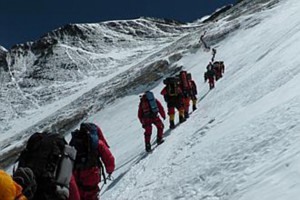( reprinted courtesy of The Sunday Times)
by David Lim
Mount Everest is turning into a circus of danger as hundreds of climbers – including the ill-prepared – join the rush to the summit.
The writer Ernest Hemingway once said that there are only three true sports in the world – the rest being merely games – and listed them as motor racing, bullfighting and mountaineering.
But in the decades since the last of the giant Himalayan peaks fell to the boots of mountaineers, has the sport of mountaineering, at least where Mount Everest is concerned, changed irreversibly, and not necessarily for the better?
Each year, like part of a tick-list for driven people, Everest sees hundreds of climbers swarming its flanks, almost all of them attempting to scale it from either its standard routes from the south in Nepal or the north, from Tibet.

Left: About 300 climbers on Mount Everest forming a long queue as they trek towards their ultimate goal of reaching the summit. Because there are only a few small windows of four to five days during the spring when climbers can reach the top in relatively good weather, the rush of mountaineers in these periods creates huge jams at bottleneck areas along the route, leading to people suffering from frostbite and other cold-related injuries while waiting.
I applaud anyone who wishes to take on the personal challenge of the peak, as it is still not an easy accomplishment.
In its purest form, the sport of mountaineering is about freedom of expression. It’s about self-determination, route finding, working as a team, and challenging yourself in a pristine, harsh and remote arena.
And yet, climbing Everest has lost most of the elements that make mountaineering what it is. For Everest at least, the aim of the game is summitting, and sometimes at all costs.
Ask those climbers this season who were told to turn around but did not, and then died on their descent, largely due to exhaustion and mistakes made in a hypoxic state of lacking oxygen.
Veteran mountain guide Dave Hahn told me more than a decade ago on my second Everest expedition that ‘there is the sport of mountaineering, and then there is this thing called Everesting’. Mr Hahn should know; he’s climbed Everest an amazing 14 times.
In ‘Everesting’, it seems more and more people want to get to the top without investing in a long and often rewarding apprenticeship in mountaineering.
Even as recently as 1998, when I led the first Singapore Mount Everest Expedition , our aim was to climb the mountain with more than minimal experience, clocking up significant time on other mountains prior to tackling the peak.
That year, taking the standard route from Nepal, 45 people summitted. This spring season on Everest, nearly 400 people have done so. In 1998, none in Nepal died. In the season just ended, 10 have died.
It is clear from this, as well as some shocking pictures this year of more than 150 people jammed up in a queue leading to the final summit camp at the 8,000m mark, that the situation on Everest is fast becoming unsustainable.
In mountaineering, there are objective and subjective dangers, the former being risks which are difficult to control, such as encountering a teetering ice tower hanging over the climbing route and not knowing when exactly it might crash down.
But what is killing more people on Everest are the subjective dangers. These are the more controllable risks, such as climbers’ physical conditioning and training, their prior experience and their development of the mountaineer’s ‘inner voice’ that is uncannily correct in helping experienced climbers make the right call in difficult situations.
Here is what is making Everest a real circus of danger: For many of the less experienced climbers who have joined a commercial expedition, most of the key decisions are made by their trip leaders. A huge amount of logistics and decision- making is out of their hands completely.
As such, there is often a lack of mountain ‘awareness’ – knowing what is in place, understanding the limits of their bodies under stress, being able to be resilient when situations change. They also have a shallow experience and skill base on which to rely when things go wrong.
On a perfectly calm day in 1998, I was horrified to see two climbers stall above me. They waited until a third climber – a guide – joined them to demonstrate something as basic as how to thread a rope into a braking device to descend a fixed rope safely. This is akin to teaching a non-driver how the brakes of a car work after you’ve let him loose on the highway.
Worse, many outfits that operate on Everest are under-equipped and when a client gets into trouble, they do not have the resources to mount a coherent rescue.
As the window of summitting in relatively stable weather in the season is usually confined to just a few periods of four to five days at a time, when people decide to make a summit push, everyone else does so too, leading to huge jams at the bottleneck areas where there is a more difficult technical challenge to be negotiated.
I know of people who have had frostbite and other such injuries from cold because they were waiting for an hour at a choke point to get their turn on the summit. It’s a recipe for disaster if bad weather then sweeps in.
A third key factor is cognitive biases at work. Among the most common is ‘sunk cost’ – most wannabe Everest climbers have saved up the US$40,000 to $65,000 (S$52,000 to S$84,000) required to have their once-in-a-lifetime shot at the summit and are loath to turn back even when wisdom dictates that they do so. More experienced climbers are invested in their sport and lives, and often make the better decision.
Another factor which can affect anyone is ‘confirmation bias’. The well-reported 1996 tragedy where eight climbers died in a single incident happened because their expedition leaders looked at the weather reports and chose to interpret the facts to merely confirm what they wanted to do – to reach the summit on a specific date, even though that date was far too close to a likely change in weather for the worse.
For years, there have been calls by some of the most respected climbers in the community to restrict the numbers going up Everest. But in a dollar-poor economy, this is unlikely to happen, at least on the Nepal side.
In addition, who would have the unenviable task of deciding who qualifies to climb and who does not?
The very ethos of the ‘freedom of the hills’ held by most mountaineers would work against any of us wanting to be the competency police on Everest.
But until some systemic changes are made to how people approach their preparation for Everest, who organises the climbs, and who are allowed to climb it, the view from Everest, for at least a few unprepared or unlucky ones, will be a view to die for.
David Lim
The writer is a leadership coach and a veteran of over 60 alpine and expedition ascents.
___________________________________________________________________________
WARNINGS OF OVERCROWDING IN ‘DEATH ZONE’ FAIL TO DETER CLIMBERS
Since the first ascent on May 29, 1953, by Sir Edmund Hillary of New Zealand and Tenzing Norgay of Nepal, about 10,000 people have tried climbing the world’s tallest peak. Almost 4,000 have succeeded in reaching the 8,848m summit.
German statistician Eberhard Jurgalski, who has chronicled Everest activity since 1981, notes that the record number of ascents in one day was 170 on May 23, 2010.
The most treacherous part is above 8,000m, the ‘death zone’. It is almost impossible to survive the biting cold and lack of oxygen for more than 48 hours.
Warnings of potentially lethal overcrowding in the ‘death zone’ this year did not deter climbers. The BBC reported that more than 300 had official permits to go up from the Nepali side, not counting locals assisting the climbers.
Popular Nepali news portal ekantipur.com said more than 350 people reached the summit.
Among those who succeeded was Dr Kumaran Rasappan, 28, the only Singaporean in an expedition of 30 people. He joins other Singaporean climbers like Malaysia-born Mr Edwin Siew and Mr Khoo Swee Chiow who did it in 1998, while Ms Jane Lee led the first women’s team from the Republic in 2009.
Since 1953, more than 220 climbers have died at Everest, half of those in the past 20 years. The deadliest season was 1996, when 15 died, eight of them on a single day.
Nepal’s tourism ministry says six climbers died this year, but unofficial sources such as mountaineering websites estimate the number of deaths to be at least 10.
